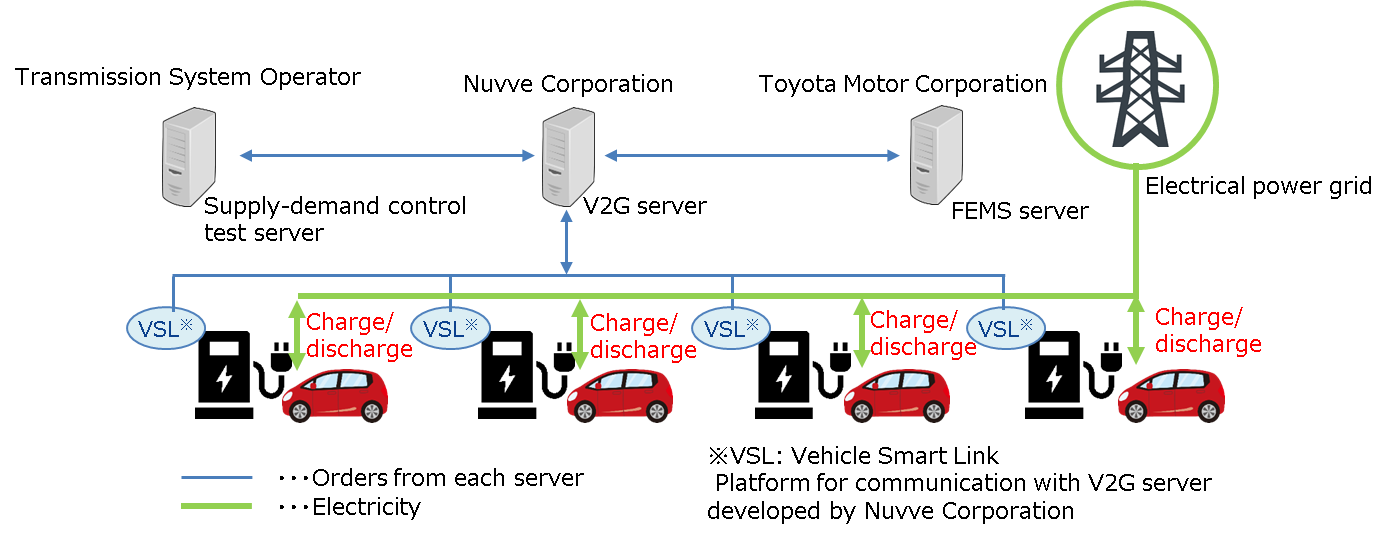Toyota Tsusho Corporation (“Toyota Tsusho”) announces that it has entered a virtual power plant (VPP)*1 vehicle to grid (V2G)*2 aggregator demonstration project that harnesses the power of energy storage in batteries of plug-in hybrid vehicles and electric vehicles (“PHEVs/BEVs”). Currently in its third year, the project plans to establish marketization of electricity supply-demand control in 2021.
Demonstrations conducted in 2018 and 2019 verified the feasibility of providing balancing control power necessary for controlling frequency and adjusting the balance of demand and supply through use of the V2G control system of Nuvve Corporation (“Nuvve”)*3–a U.S. company for which Toyota Tsusho is an investor–and managing the charging and discharging of PHEVs/BEVs based on external supply-demand control orders.
In the demonstration of fiscal 2020, besides a supply-demand control test server*4 simulating supply-demand control orders from a Transmission System Operator (TSO) following an OpenADR protocol, a factory energy management system (FEMS) that is planned to be installed within a Toyota Motor Corporation plant will also be connected to Nuvve’s V2G control system. By centrally managing the charging and discharging of 20 PHEVs/BEVs from the V2G control system based on orders received from both the supply-demand control test server and the FEMS, the project will verify the feasibility of: (1) improving efficiency of energy management for electricity demand within factories and (2) aggregating balancing control power within factories to provide balancing control power for the electricity supply-demand control market.
In addition, through the demonstration of fiscal 2020, Toyota Tsusho will build a system fulfilling security and other requirements needed when entering the electricity supply-demand control market–which is expected to be established in 2021–to create a mechanism allowing companies managing PHEVs/BEVs to participate in the supply-demand control market at low cost.
(1) Improving efficiency of energy management for electricity demand within factories
Toyota Tsusho will verify the feasibility of reducing electricity cost and improving in-house consumption rate of renewable energy by managing the charging and discharging of PHEVs/BEVs according to the state of factory electricity utilization using V2G control systems connected to energy management systems owned by the demand side such as factories.
(2) Providing for the electricity supply-demand control market by aggregating balancing control power in factories
Toyota Tsusho will verify–under real life conditions–the feasibility of providing balancing control power necessary for controlling frequency and adjusting the balance of demand and supply. This involves centrally managing the charging and discharging of PHEVs/BEVs connected to the V2G control system to improve efficiency of demand side energy management while simultaneously controlling the charging of PHEVs/BEVs based on orders received from the supply-demand control test server through OpenADR protocol. Power supply and transmission will be conducted in cooperation with Chubu Electric Power Grid Co., Inc.
■ Concept diagram of fiscal 2020 demonstration

■ Overview of fiscal 2020 demonstration
|
Period |
November to December 2020 |
|---|---|
|
Location |
Toyota Motor Corporation Honsha Plant |
|
PHEVs/BEVs |
20 Prius PHVs from Toyota Motor Corporation |
|
Bi-directional chargers |
20 bi-directional vehicle chargers from DENSO CORPORATION |
One of Toyota Tsusho’s key sustainability issues (materiality) is to contribute to the transition to a low-carbon society by reducing automotive, manufacturing, and energy plant construction CO2 emissions through the use of clean energy and innovative technologies. Starting with the investment in Nuvve in December 2017, Toyota Tsusho encourages the further spread of renewable energy and enhancing the added value of PHEVs/BEVs to contribute toward the realization of a low-carbon society and stable supply of electricity, such as undertaking the “V2G Aggregator Demonstration Project” under the “Subsidies for Virtual Power Plant Demonstration Project for Improvement of Energy Management in Demand Side” being conducted by the Ministry of Economy, Trade and Industry from 2018 to 2020.
*1 Connecting renewable power generation sources, such as solar generation systems at homes and company plants, as well as storage batteries into a single network so that they can operate as one power generation node.
*2 Utilizing the storage batteries of PHEVs/BEVs for battery charging as well as supplying stored power to the electric power grid.
*3 Nuvve Corporation is a U.S. start-up company developing V2G businesses using PHEVs/BEVs in Europe and the United States. The company provides multiple grid services such as frequency regulation service, renewable energy optimization or vehicle to building energy services. It launched the world’s first V2G commercial operation in Denmark in 2016.(https://www.toyota-tsusho.com/english/press/detail/171215_004082.html)
*4 Testing equipment designed to send balance control orders to aggregators in order for TSOs to utilize V2G. This is required to adjust power demand and supply (control frequency and adjust the balance of demand and supply) in order to maintain a fixed frequency (50Hz or 60Hz) for the electric power grid.
